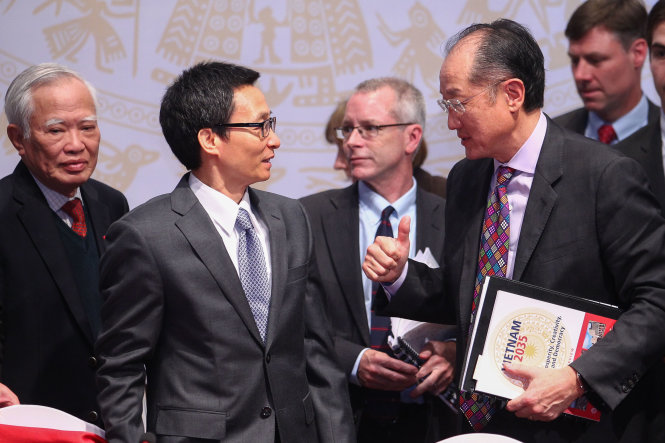The World Bank has unveiled the steps necessary for Vietnam to achieve upper-middle-income status in the next 20 years, with experts expressing optimism that the middle-income country can reach the ambitious goal.
Vietnam’s average income level in 2014 was US$2,052, or $5,370 in purchasing-power parity (PPP) terms, and the figures must be raised to $7,000, or $18,000 respectively, by 2035 for the country to become an upper-middle-income economy, according to the Vietnam 2035 report, released on Tuesday.
The report, prepared jointly by the Vietnamese government and the World Bank Group, lays out key reforms for the Southeast Asian country to grow its economy, become more equitable, and put in place modern governance over the next 20 years.
It suggests that Vietnam “build a more competitive private sector, support smart urbanization, promote innovation, and take advantage of increasing trade opportunities to enact broad structural reforms,” the World Bank said.
Such a goal requires Vietnam to grow at least seven percent per year, according to the report.
Vietnam posted a GDP growth rate of 6.68 percent in 2015 and set a 6.7 percent goal for 2016.
“In the last 30 years, Vietnam has become one of the world’s great development success stories, rising from the ranks of the poorest countries,” said World Bank Group President Jim Yong Kim.
“On the strength of a nearly seven percent average growth rate and targeted government policies, tens of millions of people have lifted themselves out of extreme poverty.”
 World Bank Group s President Jim Yong Kim holds up the Vietnam 2035 report . Photo: Reuters
World Bank Group s President Jim Yong Kim holds up the Vietnam 2035 report . Photo: Reuters
Kim said that the Vietnam 2035 report, with inputs from international and Vietnamese experts, reflects Vietnam’s aspirations of becoming a modern, industrialized nation within one generation.
The president said improvements in productivity, environmental protection and economic innovation can help Vietnam maintain high levels of growth.
He added that it will be “critically important” to remove barriers that exclude marginalized groups and deliver quality public services to an aging and urbanizing middle-class.
“The report recommends that Vietnam build modern and more transparent institutions – those steps will help the country meet its ambitious goals,” he concluded.
Last year Vietnam celebrated 70 years of independence, 40 years since reunification and just short of 30 years since the launch of reforms called Doi Moi (Renovation) in 1986.
The Doi Moi has “catapulted the nation from the ranks of the world’s poorest to one of the great development success stories,” according to the Vietnam 2035 report.
 Labourers work at an assembly of the Singlun Star garment factory outside Hanoi. Photo: Reuters
Labourers work at an assembly of the Singlun Star garment factory outside Hanoi. Photo: Reuters
The report attributed the success to visionary leaders, a sense of shared societal purpose, and a focus on the future.
“Starting in the late 1980s, these elements were fused with the embrace of markets and the global economy, setting the nation on the path to becoming the middle-income country that it is today, raising tens of millions of people out of poverty,” the document reads.
The report said Vietnam now looks to modernity, industrialization, and a higher quality of life by 2035 but should by no means be content with past success.
Such aspirations depend on three major pillars: economic prosperity, balanced with environmental sustainability; equity and social inclusion; and state capacity and accountability, according to the report.
At the ceremony to unveil the report in Hanoi on Tuesday, many experts said Vietnam can achieve the upper-middle-income status if the recommended steps, particularly about governance reform, are effectively taken in the next two decades.
Deputy Prime Minister Vu Duc Dam told the ceremony that the Vietnamese government will use the Vietnam 2035 report as reference in its policymaking process.
 An infographic by the World Bank
An infographic by the World Bank
Like us on Facebook or follow us on Twitter to get the latest news about Vietnam!


















































